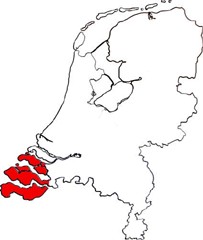The province of Zeeland, the Netherlands
 Zeeland or in English ‘See land’, includes a mainland part and the islands of Schouwen, Duiveland, Tholen, Noord-Beveland and Sint Philipsland; with the capital – Middelburg. It is to honor this province that the name of New Zealand (Dutch: Nieuw Zeeland) has been given to the newly discovered land of the southern hemisphere by the Dutch explorers in the 17c.
Zeeland or in English ‘See land’, includes a mainland part and the islands of Schouwen, Duiveland, Tholen, Noord-Beveland and Sint Philipsland; with the capital – Middelburg. It is to honor this province that the name of New Zealand (Dutch: Nieuw Zeeland) has been given to the newly discovered land of the southern hemisphere by the Dutch explorers in the 17c.
Dutch Zeeland is the province of water not only by its name. Its land is cut by the North Sea bays and the delta of big rivers with many bridges, dams, ferries, under water road tunnels which a visitor is obliged to take during the simplest tour.
Large parts of Zeeland are below the sea level. This reminds you about the task the Dutch took upon themselves through many centuries. Instead of attacking the neighbor countries, they decided to expand through struggle with the sea, to obtain the land by limiting the forces of nature.
The province of Zeeland had witnessed the most dramatic moments of the Dutch struggle with the sea: terrible floods invaded the land in 1421 and in 1916. One night in winter of 1953 the dames were broken again by the violent sea wave 3,36 m high, and the water invaded vast territories of land, destroying everything on its way. Despite the energetic salvage action of the whole nation, there were 1865 victims and more than 70 000 people lost their homes. But the Dutch took the lesson from this disaster. The Delta plan – the complex system of four huge modern dams, many secondary dams and the mobile storm surge barrier built at the mouth of the three rivers – The Rhine, The Waal and The Masas, made the whole Zeeland safer.
Today Zeeland is a province of long sandy beaches, with provincial sea resorts as snobby Domburg, modern Cadzand, and tiny Zoutelande. Small old towns which were partly protected by the water from the mainland, and nice villages seem almost untouched through centuries. Towns like Verre, Zirkzee, Goes, Hammsteded, Hulst, Sluis and villages like Sint Annater-Muiden, Dreischor, Nisse,look like centuries ago when they were busy with the sea trade, fishing, shipbuilding and crafts.
Except for an important shipyard De Schelde in Vlissingen, which proudly continues long Dutch shipbuilding tradition, Zeeland is today a quiet province, hardly showing the traces of the previous wars and conflicts. Although during the WWII the Germans did heavily bomb the old center of Middelburg, partly destroying its 15th century Town House as well some other important old buildings, today there is hardly a trace of war in this beautiful old city. The Town Hall and other buildings have been rebuilt and life there seems as peaceful as centuries ago.
The capital of the province - Middelburg is the most frequented city by the tourists visiting Zeeland. The historical museum, located in the old Abbey (Abdij) – Zeeland Museum (Zeeuws Museum) tells the visitor about the province history, beginning from the ancient Romans and Celts, showing the tapestries depicting Dutch victories on sea over the Spanish, Dutch Admiral Michiel de Ruyter who was born in a nearby Flushing, the brave commander of the sea battles against England in 17c. and finally the local folklore costumes and hats and scenes of everyday life.
